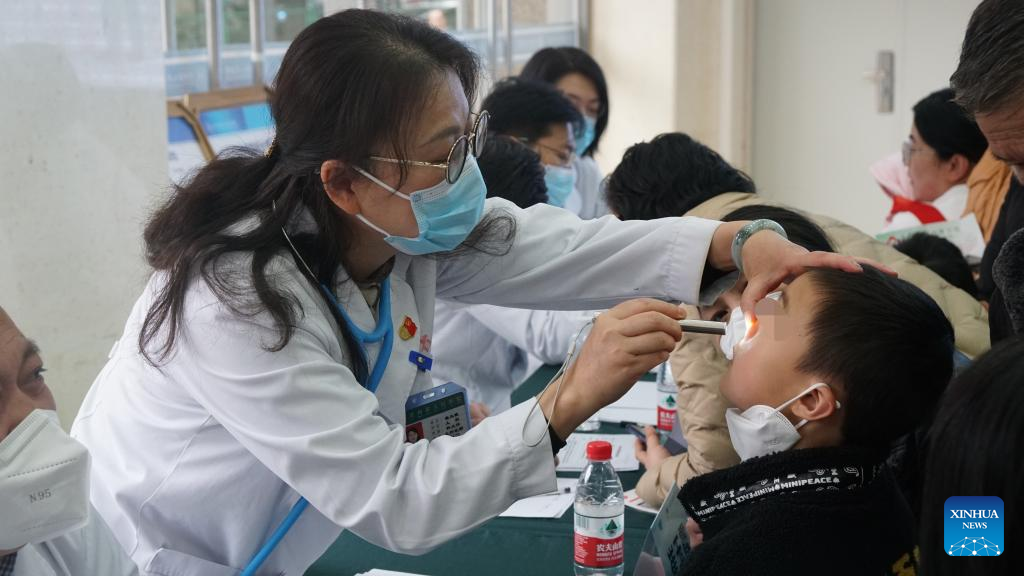China more resolute to fight rare diseases

A doctor gives a boy medical treatment during an event held by Guizhou Provincial People's Hospital and the Guizhou Hospital of Shanghai Children's Medical Center to provide children with free multidisciplinary consultation and gene tests in Guiyang, southwest China's Guizhou Province, Feb. 28, 2023. (Xinhua)
GUIYANG, Feb. 28 (Xinhua) -- Wang Chaobin (pseudonym) and his wife, residents in southwest China's Guizhou Province, gave birth to two babies, who both passed away when they were less than one year old.
Their third child developed symptoms of coughing, wheezing, and breathing difficulties when he was nine months old. After treatment at the Guizhou Hospital of Shanghai Children's Medical Center, the little boy was temporarily out of danger.
After knowing the couple's reproductive history, doctors at the hospital carried out tandem mass spectrometry and gene testing. They found that the third child suffers from a rare disease -- primary carnitine deficiency combined with dilated cardiomyopathy.
Wang Xike, a pediatrician at the hospital, said this rare disease is mostly found in infancy and results from gene disorders. "Despite low incidence, the disease should be diagnosed and treated in time, which helps reduce the damage to the heart muscle and organs and improve the life quality of children," Wang added.
Now, the boy has his disease under control with the oral drug L-carnitine. He can go to kindergarten and enjoy his childhood like other children.
There are more than 7,000 rare diseases and 350 million related patients worldwide. About 80 percent of rare diseases are hereditary, and some 50 percent start in childhood.
Most rare diseases can neither be identified and diagnosed in time nor treated effectively, thus bringing a massive burden to society and the family.
China has about 20 million patients with rare diseases, with more than 200,000 new cases found annually. In January, seven drugs for rare diseases, including pulmonary hypertension and amyotrophic lateral sclerosis, were added to the national medical insurance drug list. At present, there are 52 drugs on the list covering 27 rare diseases.
Before the Spring Festival holiday in 2023, six-year-old Xiaoshen (pseudonym) was hospitalized for bronchitis in a county hospital in south China's Guangxi Zhuang Autonomous Region. He was diagnosed with spinal muscular atrophy (SMA) when he was one and a half years old.
"Due to this disease, he is too weak to hold the spoon and easily chokes while sitting and eating," said Qin Li, Xiaoshen's mother. Thanks to the Chinese government's centralized drug-procurement program, the price of a single jab of the drug Nusinersen to treat SMA decreased from 700,000 yuan (about 101,000 U.S. dollars) to 33,000 yuan. China's national health insurance will cover most of the expenses, and they only need to pay some 8,000 yuan.
"With the drug, we have hope," said Qin.
From the diagnosis and publication of a catalog of rare diseases to drug development and establishment of a medical collaboration network, China has made great efforts to improve the public's awareness and treatment ability of rare diseases.
Cui Dao, a resident from Guizhou, took his child to have a physical examination in a local hospital and was told to take the child to Shanghai to figure out a problem with the youngster's hip joint. Fortunately, experts from Shanghai came to Guizhou.
"We can enjoy convenient medical services in the province, which helps save time and money for traveling," said Cui.
Since November 2022, experts from Shanghai Children's Medical Center have come to Guizhou to carry out diagnosis, treatment, and operations for children with complex and baffling diseases, including rare diseases.
In March, Guizhou Hospital of Shanghai Children's Medical Center will be put into formal operation in the capital city of Guiyang. This public hospital is one of the fourth batches of China's regional medical centers to bring high-quality medical resources from the east to the western regions.
"We try to reduce the incidence of rare diseases from the very beginning of life," said Ge Yihua, a senior doctor at Guizhou Hospital of Shanghai Children's Medical Center.
There are more than 8,000 known birth defects, and a large proportion are rare. China has encouraged premarital examination, birth examination, and newborn screening to prevent birth defects.
There are now more than 4,800 prenatal screening institutions and some 500 prenatal diagnostic institutions nationwide, offering early screening, treatment and intervention for rare diseases.
Photos
Related Stories
- Feature: Chinese moms share stories of daughters battling rare Rett syndrome
- Yearender: China strives to improve people's well-being, raise quality of life
- China moves to further integrate medical and elderly care services
- China expands access to national insurance-covered drugs
- China to deepen efforts in integrating medical, elderly care
Copyright © 2023 People's Daily Online. All Rights Reserved.









